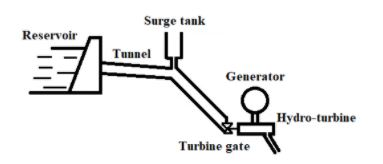
Water falls from a height of $60m$ at the rate of $15Kg{{s}^{-1}}$ to operate a turbine. The losses due to frictional forces are $10%$ of energy. How much power is generated by the turbine? $\left( g=10m{{s}^{-2}} \right)$
Answer
575.1k+ views
Hint: A hydraulic turbine is used to convert the energy of flowing water into the mechanical energy. A hydroelectric generator then converts this mechanical energy into electricity. For calculating the power of a hydraulic turbine, we need to know the value of height of water fall in the turbine, and the rate of mass flow of the water in the turbine.
Formula used:
Power generated by the turbine, $P=gh\left( \dfrac{m}{t} \right)$
Complete step-by-step answer:
Hydraulic turbine, also known as a hydro turbine or water turbine; is a rotary machine that has the capability to convert the kinetic energy and the potential energy of flowing, or falling, water into mechanical work. A generator converts the mechanical energy from the turbine into electrical energy, which can be further used to satisfy various purposes. Hydropower plants basically capture the energy of falling water in order to generate the electricity.

The power generated by a water turbine is given as:
$P=Q\times \rho \times g\times h\times \eta $
Where,
$P$ is the mechanical power $\left( KW \right)$
$Q$ is the flow rate in the pipe $\left( {{m}^{3}}{{s}^{-1}} \right)$
$\rho $ is the density of the water $\left( Kg{{m}^{-3}} \right)$
$g$ is the acceleration due to gravity $\left( m{{s}^{-2}} \right)$
$h$ is the waterfall height $\left( m \right)$
$\eta $ is the efficiency
Rewriting the formula,
$P=gh\left( \dfrac{m}{t} \right)$
Where,
$P$ is the mechanical power $\left( KW \right)$
$g$ is the acceleration due to gravity $\left( m{{s}^{-2}} \right)$
$h$ is the waterfall height $\left( m \right)$
$\dfrac{m}{t}$ is the rate of mass flow of the water $\left( Kg{{s}^{-1}} \right)$
Given that,
Height of the water level is,
$h=60m$
Rate of falling of water,
$\dfrac{m}{t}=15Kg{{s}^{-1}}$
Acceleration due to gravity,
$g=10m{{s}^{-2}}$
Input of the turbine is $gh\left( \dfrac{m}{t} \right)$
The losses due to frictional force is $10%$, means that the $90%$ of the input is used to generate the power,
Output power is given as,
$P=\dfrac{90}{100}\left( gh\times \dfrac{m}{t} \right)$
Putting values,
$\begin{align}
& g=10m{{s}^{-2}} \\
& h=60m \\
& \dfrac{m}{t}=15Kg{{s}^{-1}} \\
\end{align}$
$\begin{align}
& P=\dfrac{90}{100}\times 10\times 60\times 15 \\
& P=8100W \\
& P=8.1KW \\
\end{align}$
The power generated by the turbine is $8.1KW$
Note: In order to generate electricity in a hydraulic turbine, water must be in motion. The flowing water possesses kinetic energy. When falling water turns the blades in a turbine, the form is changed to mechanical energy. The hydraulic generator rotor then converts this mechanical energy into electrical energy.
Formula used:
Power generated by the turbine, $P=gh\left( \dfrac{m}{t} \right)$
Complete step-by-step answer:
Hydraulic turbine, also known as a hydro turbine or water turbine; is a rotary machine that has the capability to convert the kinetic energy and the potential energy of flowing, or falling, water into mechanical work. A generator converts the mechanical energy from the turbine into electrical energy, which can be further used to satisfy various purposes. Hydropower plants basically capture the energy of falling water in order to generate the electricity.

The power generated by a water turbine is given as:
$P=Q\times \rho \times g\times h\times \eta $
Where,
$P$ is the mechanical power $\left( KW \right)$
$Q$ is the flow rate in the pipe $\left( {{m}^{3}}{{s}^{-1}} \right)$
$\rho $ is the density of the water $\left( Kg{{m}^{-3}} \right)$
$g$ is the acceleration due to gravity $\left( m{{s}^{-2}} \right)$
$h$ is the waterfall height $\left( m \right)$
$\eta $ is the efficiency
Rewriting the formula,
$P=gh\left( \dfrac{m}{t} \right)$
Where,
$P$ is the mechanical power $\left( KW \right)$
$g$ is the acceleration due to gravity $\left( m{{s}^{-2}} \right)$
$h$ is the waterfall height $\left( m \right)$
$\dfrac{m}{t}$ is the rate of mass flow of the water $\left( Kg{{s}^{-1}} \right)$
Given that,
Height of the water level is,
$h=60m$
Rate of falling of water,
$\dfrac{m}{t}=15Kg{{s}^{-1}}$
Acceleration due to gravity,
$g=10m{{s}^{-2}}$
Input of the turbine is $gh\left( \dfrac{m}{t} \right)$
The losses due to frictional force is $10%$, means that the $90%$ of the input is used to generate the power,
Output power is given as,
$P=\dfrac{90}{100}\left( gh\times \dfrac{m}{t} \right)$
Putting values,
$\begin{align}
& g=10m{{s}^{-2}} \\
& h=60m \\
& \dfrac{m}{t}=15Kg{{s}^{-1}} \\
\end{align}$
$\begin{align}
& P=\dfrac{90}{100}\times 10\times 60\times 15 \\
& P=8100W \\
& P=8.1KW \\
\end{align}$
The power generated by the turbine is $8.1KW$
Note: In order to generate electricity in a hydraulic turbine, water must be in motion. The flowing water possesses kinetic energy. When falling water turns the blades in a turbine, the form is changed to mechanical energy. The hydraulic generator rotor then converts this mechanical energy into electrical energy.
Recently Updated Pages
Why are manures considered better than fertilizers class 11 biology CBSE

Find the coordinates of the midpoint of the line segment class 11 maths CBSE

Distinguish between static friction limiting friction class 11 physics CBSE

The Chairman of the constituent Assembly was A Jawaharlal class 11 social science CBSE

The first National Commission on Labour NCL submitted class 11 social science CBSE

Number of all subshell of n + l 7 is A 4 B 5 C 6 D class 11 chemistry CBSE

Trending doubts
What is meant by exothermic and endothermic reactions class 11 chemistry CBSE

10 examples of friction in our daily life

One Metric ton is equal to kg A 10000 B 1000 C 100 class 11 physics CBSE

1 Quintal is equal to a 110 kg b 10 kg c 100kg d 1000 class 11 physics CBSE

Difference Between Prokaryotic Cells and Eukaryotic Cells

What are Quantum numbers Explain the quantum number class 11 chemistry CBSE




